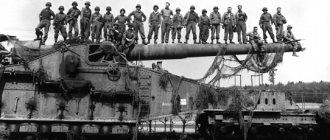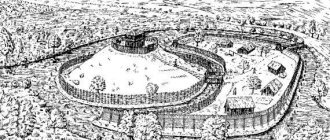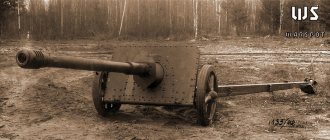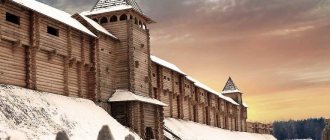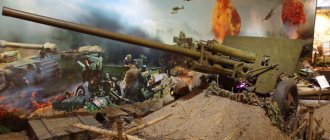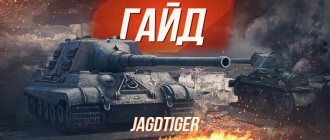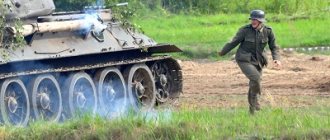Author: zaCCCPanec
16 April 2022 14:42
Tags: WWII artillery history pages
2849
16
With Hitler coming to power in 1933, work on creating new types of weapons and military equipment intensified in Germany. The militarization of the country continued at an increasing pace, while the Germans managed to achieve success in almost all areas. They were also very noticeable in artillery, where the German design school was especially strong and relied on the rich experience and heritage of the First World War.
0
See all photos in the gallery
The experience of the First World War dictated the construction of super-powerful artillery systems that could be effectively used against long-term enemy fortifications or especially fortified positions. Fortunately, the targets for the new guns were, for example, the French Maginot Line fortifications. Combat experience told the Germans that monstrous guns were effective against fortresses and forts. The famous “Big Bertha” was a living proof of this.
Mortar Karl 600 mm and 540 mm performance characteristics. Firing range. Weight. Dimensions
Artillerymen of the 2nd battery of the 833rd heavy artillery battalion of the Wehrmacht are preparing to fire a 600-mm self-propelled mortar "Karl" (Karl Gerät 040 Nr.III "Odin") in the Brest area. In the photo near the mortar is a Munitionsschlepper shell carrier on the chassis of a Pz.Kpwf tank. IV Ausf. E.
Self-propelled mortar "Karl" (German: Gerät 040 - product 040; after modernization - German: Gerät 041) - German heavy self-propelled mortar of the Second World War. A total of seven examples were built. They were used to storm fortresses and heavily fortified enemy positions.
Pavilion “European and Japanese Technology”
This pavilion displays a unique collection of Japanese armored vehicles - tanks of the 30s, used in battles near Lake Khasan and the Khalkhin Gol River. As well as technology from European countries.
Medium tank MK V
I don't remember the name of the tank, but it looks cool
Mortar Karl - video
The history of the Karl self-propelled mortar began in 1935 with the development of a 600 mm rifled mortar, which could fire projectiles weighing up to four tons at a distance of just over a thousand meters. The design was carried out under the leadership of artillery general Karl Becker, so the vehicle, which had the factory index Gerät 040 (product 040), received the semi-official name “Karl”. A prototype of the gun was produced in 1937. The impressive mortar, weighing about 55 tons, threw two-ton shells at a distance of up to 3,000 m. Such an impressive weapon had only one significant drawback - bulkiness, so in the same year work began on creating a self-propelled carriage for it. When the carriage was developed, the total weight of the artillery system reached 97 tons. After the designers received the task of booking the carriage, the weight of the installation rose to 126 tons. The gun barrel was also modernized, increasing its length to 5,108 mm and thereby increasing the range to 4,000 m. Prototype with an eight-wheel tracked chassis was successfully tested in May 1940. Then, from November 1940 to August 1941, a small batch of installations was built.
The German 600-mm self-propelled mortar "Karl" (installation VI "Ziu" - German name 60-cm-Mörser "Karl - Gerät 040, Geschütz VI "Ziu") fires at rebel positions in Warsaw.
manufactured one prototype and six combat self-propelled mortars. Since the installations were single products, each of them received its own name:
I - “Adam” (German Adam), later renamed “Baldur” (German Baldur); II - “Eva” (German: Eva), later renamed “Wotan” (German: Wotan); III - “One” (German: Odin); IV - “Thor” (German Thor); V - “Loki” (German: Loki); VI - “Ziu” (German: Ziu); VII - "Fenrir" (German: Fenrir) - prototype - did not participate in battles.
In November 1940, the first mortar, "Adam", was handed over to the troops. By mid-April 1941, three installations were commissioned - “Eva”, “Thor” and “Odin”, and by the end of August two more - “Loki” and “Tsiu”.
There was also a seventh installation, named "Fenrir", but it was used mainly for testing and was not used in battle. Perhaps this name refers to the prototype installation built in May 1940.
Shell for the German 600-mm mortar Karl
Chassis
A unique feature of this weapon is the presence of a tracked part, with the help of which the weapon could independently move over short distances at speeds of up to 10 km/h. Structurally, the chassis was a tracked vehicle with a welded armored body, reinforced with stiffening ribs. A 12-cylinder in-line liquid-cooled Daimler-Benz 507 diesel engine with a power of 750 hp was installed in the bow of the hull. s., and a hydromechanical transmission with three torque converters activated in turn. The two-stage planetary rotation mechanism is equipped with a pneumatic servo drive. The actual chassis of the production vehicles was somewhat different from the chassis of the prototype and, for one side, consisted of eleven small-diameter road wheels with an individual torsion bar suspension, five support rollers, a rear idler and a front drive wheel. The width of the lantern track was 500 mm, the support area was 7 m².
To ensure the necessary stability when firing, the vehicle was lowered to the ground before firing. For this purpose, the torsion bar suspension of the track rollers of the tracked undercarriage was connected to a mechanism for lowering the vehicle to the ground located in the stern. The gearbox, driven by the engine, rotated the ends of the torsion bars opposite the balancers to a certain angle through a lever system. Transferring the vehicle from the traveling position to the combat position (with the vehicle lowered to the ground) took 10 minutes.
An unexploded 600-mm Karl mortar shell that fell on the 30th coastal defense battery. Sevastopol, 1942.
Artillery unit
The artillery part of the vehicle was a 600-mm rifled mortar installed in a machine in the middle of the hull. The mortar barrel is a monoblock. The wedge lock is horizontal, with a cylindrical-prismatic wedge. Using lifting mechanisms, it was possible to achieve a maximum barrel elevation angle of +70°, and the horizontal aiming angle was 4°. The aiming mechanisms were operated manually. To absorb the strong recoil of the mortar, a two-stage recoil system was developed - when fired, not only the barrel in the cradle, but also the entire machine in the machine body rolled back.
For firing, light and heavy concrete-piercing projectiles with a weight of 1700 kg (including 280 kg of explosives) and 2170 kg (including 348 kg of explosives), as well as high-explosive (Sprenggranate) weighing 1250 kg (including 460 kg explosives).
A concrete-piercing projectile weighing 2170 kg was fired with an initial speed of 220 m/s and pierced a concrete wall 3 to 3.5 m thick or a steel slab 450 mm thick. The initial speed of the high-explosive projectile was 283 m/s, it was fired at a distance of 6,700 m. The maximum flight time of the projectiles was 49 seconds.
The gun's rate of fire was one shot every 10 minutes.
The gun's ammunition consisted of eight rounds of separate cartridge loading (constant charge) and was transported on ammunition transporters specially designed on the basis of the PzKpfw IV tank. Each transporter had a 2.5-ton crane that lifted the shells and placed them on the mortar tray. Three shells were placed on the tray.
Self-propelled mortars "Karl" in a firing position. The installations are armed with 540 mm caliber mortars
In 1943, at least two mortars (“Loki” and “Thor”), after exhausting their warranty service life, received interchangeable 540-mm barrels with a length of 11.5 calibers. After modernization, the installations began to be designated “Gerät 041”. The shells of these mortars weighing 1580 kg (concrete-piercing) and 1250 kg (high-explosive) were fired at a range of up to 10,400 m. Otherwise, the characteristics of the installation remained unchanged. The available photograph (on the right), which shows mortars rearmed with 540-mm barrels, suggests that at least three mortars were rearmed with such barrels (that is, “Loki”, “Thor” and a certain third).
Transportation of self-propelled mortar "Karl" by rail
Transportation
Using a self-propelled carriage, the mortar could independently maneuver at speeds of up to 10 km/h, but the cruising range of the installation was very limited. When transported by rail, the installation was suspended between two specially equipped five-axle platforms. Along the highway, the car was transported disassembled on trailers. For this purpose, the installation was disassembled into four parts:
— trunk cart weighing 42 tons; — upper carriage weighing 41.8 tons; — axle and chassis weighing 21.6 tons; — self-propelled carriage weighing 82.3 tons.
In this case, the self-propelled carriage was installed on a six-axle trailer, and three four-axle platforms were used to transport the remaining parts.
Demonstration photo of the German 600-mm self-propelled mortar "Karl" (Karl Gerät 040) and the Munitionsschlepper shell carrier on the chassis of the Pz.Kpwf tank. IV Ausf. E. A total of seven copies of this mortar were built. Each mortar had its own name. This example, with serial number 3, bore the name “Odin” (Werk Nr.III “Odin”).
Combat use
Self-propelled mortars "Karl" were in service with the 628th and 833rd special artillery divisions of the Wehrmacht (three guns in each division; later one mortar was transferred from the 628th to the 833rd division, in which two batteries of two were formed guns). Tactically, guns of this type were intended to destroy heavily fortified fortifications, in particular, the forts of the French Maginot Line. However, due to the transience of the French campaign, the vehicles were never used to storm it - only a prototype of the vehicle was ready by the end of the campaign, and in the end there was no need to storm the Maginot Line.
The 1st battery of the 833rd division (Adam, Eve and 60 shells) was delivered to the location of the 17th Army (Army Group South), and the 2nd battery (Thor and Odin and 36 shells) were transported to Terespol and assigned to Army Group Center. The battery was supposed to participate in the assault on the Brest Fortress.
Mortars were first used in combat conditions on June 22, 1941 - “Odin” and “Thor” as part of the battery of the 833rd division repeatedly fired at the Brest Fortress. Moreover, on the first day of use, after several shots in both installations, the shells jammed and it took time to fix this problem.
The 1st battery, which was to operate as part of the 4th Corps of the 17th Army, was transported by rail to Przemysl. Moving under its own power to the firing positions, one of the self-propelled guns - “Eva” - suffered an accident (the caterpillar broke) and did not participate in the battles. The Adam mortar fired only 4 shells against the Soviet fortifications, the so-called “Molotov Line,” accompanying the attack of the 295th Infantry Division with its fire. By the way, a company from the same division was assigned to guard the Karlov positions.
German 600-mm self-propelled mortar "Karl" (60 cm Mörser Karl-Gerät 040) in a combat position in a caponier near Sevastopol. The photo shows the moment the gun was loaded. On the right are captured Soviet GAZ-AA trucks.
In a report dated June 23, 1941, the corps command noted that there was no need to continue using the Karlov battery, drawing attention to the technical difficulties of using these self-propelled guns. As a result, the 1st battery was sent back to Germany.
In the diary of the Chief of the German General Staff Halder for June 24, 1941, it appears that he issued instructions to Artillery General Brand to find out the effectiveness of the fire from the Karl installations in the Brest area. On June 28, General Brand's report was announced; the operation of the Karl artillery systems was considered very effective.
After the capture of the Brest Fortress, it was possible to establish that the concrete bunkers did not receive direct hits at all. The size of the craters in the ground is within a radius of 15 meters and a depth of 5 meters. Two shells did not explode. During the explosion, a cloud of smoke and dust rose to a height of 170 meters.
The report on the use of the Karl mortars was submitted personally to Adolf Hitler.
On August 6, 1941, the 833rd division was re-equipped with 8 towed 210 mm mortars and sent to the Eastern Front. Karl mortars were used during the siege of Sevastopol, together with the Dora super-heavy railway artillery gun.
One mortar (most likely “Adam”), after repair, was sent to Terespol for display to Benito Mussolini, who was at that time on the Eastern Front.
Concrete-piercing shell mortar Karl
In preparation for the attack on Sevastopol, planned for early summer, on February 18, 1942, the 833rd Heavy Artillery Battalion was ordered to form a Karlov battery with 2 Thor and Odin guns. To minimize Soviet fire before they could move into combat position, camouflaged trenches 15 meters long, 10 meters wide and 3 meters deep were dug for each howitzer. On May 20, 1942, the 11th Army reported that both guns and 73 heavy and 50 light concrete-piercing shells were at the front. The 54th Army Corps reported that 19 heavy shells were fired on June 2-6, 54 on June 7, and all 50 light shells were fired on June 8-13. By the end of the month, another 29 heavy and 50 light shells were delivered. All 50 light shells were fired on June 30 and 25 heavy shells the next day. The 197th of these shells fired at 2 305-mm double-barreled armored towers of the 30th coastal defense battery, although they hit only 1 tower and knocked out electricity in the 2nd, which was repaired. On July 19, 1942, the Karlov battery was ordered to send its guns to Hillersleben for repairs.
In August 1944, the Tsiu installation shelled Warsaw during the suppression of the Warsaw Uprising.
In 1945, mortars named "Eve" and "Loki" were captured by the US Army. In addition, the Fenrir experimental installation also fell into the hands of the Americans. The Tsiu installation became a trophy of the Red Army, which captured it on April 20, 1945 near the town of Jüterbog. The remaining three installations were apparently destroyed by the Germans themselves.
Tactical and technical characteristics of the Karl mortar
— Classification: self-propelled mortar - Developer: Rheinmetall - Years of production: 1940-1941 - Years of operation: 1940-1945 - Number of units produced: 1 prototype and 6 serial self-propelled guns
Mortar weight Karl
— Combat weight, t: 126
Crew: 16 people
Overall dimensions of the mortar Karl
— Case length, mm: 11,370 — Width, mm: 3160 — Height, mm: 4780
Reservation of the mortar Karl
— Armor type: rolled steel — Hull front, mm/deg.: 10 — Hull side, mm/deg.: 10 — Hull rear, mm/deg.: 10 — Bottom, mm: 10 — Hull roof, mm: 10
Mortar armament Karl
— Caliber and brand of gun: 600 mm (040), 540 mm (041) — Type of gun: mortar — Barrel length, calibers: 8.44 (040), 11.5 (041) — Gun ammunition: 4 shots — Angles VN, degrees: 0…+70° — Angles GN, degrees: 4°
Karl mortar firing range
- 4.5 km (concrete-piercing projectile), 6.7 km (high-explosive projectile)
Karl mortar engine
— Engine type: V‑shaped 12‑cylinder diesel liquid cooled — Engine power, l. pp.: 750
Mortar speed Karl
— Highway speed, km/h: 10 — Suspension type: torsion bar, hydraulic, with the ability to lower the body to the ground
What did we see in the museum?
There are 7 pavilions on the territory of the museum: 1. Pavilion No. 1. Heavy tanks of the Soviet Army 2. Pavilion No. 2. Medium and main battle tanks of the Soviet Army and the Russian Federation 3. Pavilion No. 3. Light tanks of the Soviet Army and Airborne Forces equipment 4. Pavilion No. 4. Tracked and wheeled vehicles of the Soviet Army and the Russian Federation 5. Pavilion No. 5. Technology of Great Britain, Canada, USA 6. Pavilion No. 6. Technology of Nazi Germany 7. Pavilion No. 7. Technology of European countries and technology of Japan.
At the very end of the alley there is an administration and a buffet. By the way, there is also a toilet on site. Well, just in case. The Kubinka Tank Museum occupies several huge hangars (not heated), but some exhibits are located in the fresh air. Interestingly, in each of the pavilions there are informational historical stands dedicated to the theme of the pavilions.
Photo of mortar Karl
Mortar "Karl" in the museum of armored vehicles in Kubinka
German heavy 600-mm self-propelled mortars "Karl" (Gerät 040, "installation 040"). Nearby are Pz.Kpfw ammunition transporters. IV Munitionsschlepper. The Karl mortars, like the Dora artillery system, in my opinion, are a relict echo of the First World War, a demonstration of high-tech industry and a developed economy (especially given Schickelgruber’s love for massive and huge weapons). But on the other hand, “Dora” was being prepared for Maginot, which was passed over, so there were no worthy goals for it. But “Karl” fought, dueling with the 30th battery in Sevastopol for several months. He had his own successes, hitting targets that could not be hit in any other way - neither with other calibers, nor with aircraft. So useful, the German industry did not go bankrupt for 4 copies. The larger the caliber, the less often (if at all) it is used, but when the time comes it is irreplaceable. The Red Army also had not very modern 305 mm howitzers of the 1905 model. And how useful they were during the storming of Koenigsberg! Only once, but very useful.
Similar
SAU 2S7 Pion (2S7M Malka) performance characteristics. Caliber. Dimensions. Firing range
MLRS BM-21 Grad. Damage area. Rockets. Caliber. Story
120-mm mortar 2B11 complex 2S12 Sani TTX. Firing range. Weight
Mortar 2B9M Vasilek 82 mm Rate of fire. Firing range. Weight
Self-propelled gun 2S3 Akatsiya 152 mm. Firing range. Dimensions. Weight. Engine
SAU 2S1 Gvozdika 122 mm Firing range. Dimensions. Device. Weight
Gun 2A36 Giatsint-B 152 mm. Firing range. Dimensions. Device
MLRS 9K58 Smerch Damage area. Rockets. Caliber. Story
MT-12 Rapier gun. Firing range. Story. Dimensions
Howitzer D-30 122-mm performance characteristics. Firing range. Dimensions. Weight
2S4 Tulip self-propelled mortar 240 mm performance characteristics. Dimensions. Firing range. Weight
Self-propelled gun 2S35 Koalitsiya-SV 152-mm performance characteristics. Firing range. Dimensions. Weight
Howitzer Msta-B (2A65) 152 mm. Firing range. Dimensions. Weight. Ammunition
Self-propelled gun 2S9 Nona-S 120 mm performance characteristics. Firing range. Dimensions. Weight. Armament
AT-T heavy artillery tractor. TTX. Dimensions. Engine. Story
SAU 2S19 Msta-S 152 mm Dimensions. Speed. Engine. Story
MLRS 9K57 Hurricane Damage area. Rockets. Caliber. Story
TOS-1 Buratino (TOS-1A Solntsepek) performance characteristics. Damage area
Divisional gun ZIS-3 76 mm. TTX. Firing range. Dimensions. Weight
Howitzer gun D-20 152 mm performance characteristics. Firing range. Dimensions. Weight
Howitzer M-30 model 1938 122-mm performance characteristics. Firing range. Dimensions. Weight
Self-propelled gun 2S5 Giatsint-S 152 mm performance characteristics. Firing range. Armament. Dimensions. Weight
Self-propelled gun Ferdinand (Elephant) performance characteristics. Reservation. Weight. Dimensions
Self-propelled gun SU-100. TTX. Armament. Dimensions. Shells. Weight. Speed
Self-propelled gun Sturmtiger caliber 380 mm. TTX. Armament. Shells. Reservation. Dimensions
203-mm howitzer B-4 model 1931 performance characteristics. Weight. Ammunition. Dimensions
Self-propelled gun SU-152 St. John's wort 152 mm performance characteristics. Shells. Firing range. Dimensions. Weight
Gun M-46 130-mm performance characteristics. Firing range. Dimensions. Weight
Demining installation UR-77 Meteorite TTX. Armament. Dimensions
MLRS 9K51M Tornado-G. Rockets. TTX. Firing range. Dimensions
SAU 2S31 Vienna 120 mm. Firing range. Story. Dimensions. Weight
German self-propelled gun StuG III. Modifications. Dimensions. Armament. Weight
Guided projectile Krasnopol. TTX. Firing range. Dimensions. Price
Mortar Karl 600 mm and 540 mm performance characteristics. Firing range. Weight. Dimensions
Big Bertha 420 mm gun. TTX. Weight. Dimensions. Ammunition
Self-propelled gun SU-76. TTX. Dimensions. Reservation. Weight. Story
SAU 2S23 Nona-SVK 120-mm performance characteristics. Armament. Range and accuracy of fire. Dimensions
SAU 2A3 Condenser-2P caliber 406 mm Firing range. Armament. Dimensions. Weight
Mortar M-160 caliber 160-mm performance characteristics. Firing range. Ammunition. Dimensions
Airborne self-propelled gun ASU-57. Armament. TTX. Dimensions. Weight. Booking
Artillery complex A-222 Bereg 130 mm. TTX. Firing range. Ammunition
Howitzer BR-18 caliber 305 mm TTX. Firing range. Weight
152 mm howitzer D-1. Firing range. Dimensions. Weight. Device
Mortar M-240 caliber 240 mm. Firing range. Dimensions. Weight
Self-propelled gun SU-85. Ammunition. Reservation. Dimensions. Weight. Engine
Counter-battery radar Zoo-1 (1L219M). Range of control of firing positions. Device
SAU 2S25 Sprut-SD. Caliber. Story. Dimensions. Weight. Engine
Self-propelled gun 2S34 Hosta 120 mm. TTX. Dimensions. Firing range. Armament. Weight
Self-propelled gun ASU-85. Armament. Dimensions. Reservation. Weight
280-mm mortar Br-5 model 1939 Dimensions. Weight. Ammunition
Self-propelled gun 2A45M Sprut-B. TTX. Speed. Engine. Weight
Belarusian MLRS BelGrad. TTX. Firing range. Ammunition. Dimensions
S-23 cannon 180 mm caliber. Ammunition. Weight. Dimensions. Firing range
Self-propelled gun SAU SU-122. Dimensions. Armament. Reservation. Weight
Self-propelled gun Jagdpanther. Weight. Reservation. Dimensions. Armament
Multi-barreled self-propelled gun M50 Ontos. TTX. Armament. Dimensions. Booking
D-74 cannon 122 mm caliber. Firing range. Dimensions. Weight
Artillery tractor T-20 Komsomolets. Armament. Reservation. Dimensions. Weight
Artillery tractor YA-12. Dimensions. Weight. Load capacity. Engine
SAU ISU-122. Armament. Dimensions. Weight. Booking
RPU-14 (8U38) - rocket launcher
2K32 Deva - 82-mm self-propelled mortar system
MLRS BM-24 (T) 240 mm. Firing range. Dimensions. Weight. Engine
Artillery tractor Comintern. Load capacity. Dimensions. Weight. Engine
Self-propelled gun SU-122-54. Reservation. Dimensions. Weight. Firing range
MLRS BM-14-16. Armament. Dimensions. Weight. Firing range
Self-propelled gun Nashorn (Rhinoceros). Armament. Dimensions. Weight. Booking
BR-2 gun caliber 152 mm. Firing range. Dimensions. Weight
Self-propelled howitzer self-propelled gun PzH 2000. Firing range. Dimensions. Weight
BR-17 cannon 210 mm caliber. Weight. Firing range. Rate of fire
Self-propelled gun Vespe 105 mm. Armament. Dimensions. Reservation. Weight
Wheeled self-propelled gun GAZ-68 (KSP-76). Armament. Dimensions. Weight. Engine
Self-propelled gun Brummbar 150 mm. Armament. Dimensions. Weight. Booking
Heavy self-propelled gun SU-14. Reservation. Dimensions. Weight. Engine
Self-propelled gun SU-5. Armament. Reservation. Dimensions. Weight
Self-propelled gun AT-1. Reservation. Dimensions. Weight. Engine
Self-propelled gun SU-12. Armament. Reservation. Dimensions. Weight
How to get to the tank museum in Kubinka:
By rail: take the train to the Kubinka station in the Belorussian direction, exit to the left side, then by minibus No. 59 to the stop “Armored Vehicle Museum” (IS-3 tank on the Minsk highway), then straight along the road, keeping to the left, along the fence to gate of the Armored Vehicles Museum. By road: up to 64 km. Minsk highway I want to immediately warn you that if you are planning to go on the weekend, you need to leave early, as there is a traffic jam even at the exit. Landmark - IS-3 tank on the left. From the tank to the left in the field there is a road 400 m to the checkpoint and ticket office. (approx. turning left is PROHIBITED, go forward 400 m, overpass “figure eight” and back to Moscow to the tank)
As for our trip, we drove to Kubinka along the Minsk highway, and returned along the Kyiv highway. It took about 1 hour from Moscow.
The exact address of the tank museum in Kubinka: Moscow region, Odintsovo district, Kubinka-1 Telephone for inquiries and booking excursions: 8-926-959-07-56 Opening hours: Wednesday to Sunday from 10-00 to 18-00. In the winter season - until 16-00. Attention, foreign citizens need to obtain a special permit. Details can be found by calling 8-(926)-959-07-56. Official website of the tank museum: www.mbtvt.ru

